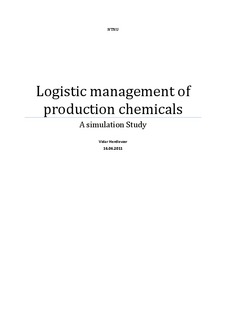| dc.description.abstract | This paper evaluates the logistics for production chemicals used on the offshore installations of the coast of Norway. Statoil provided the following problem description: There are an increasing number of fields on the Norwegian continental shelf that are going in to mature stage of its production. In this part of the field’s life cycle the need for production chemicals are increasing. The problem for the supply chain is that the tank capacity on-board the installations are limited and the procurement process is significant. The technology on the tanks on-board is old and manual readings of the tank level are needed. This could lead to the need for priority calls by the supply vessels, which are costly, or in the worst case stop in production.
In the first part of the paper the offshore supply chain at Statoil is described, and a description of the importance of the production chemicals is given. A brief description of the theory related to the problem within the subject of Supply Chain Management is provided, and a chapter describing the field work at Statoil is also given. It was concluded that simulation modelling was to be used in the analysis part of the work.
Discreet event simulation is a common method for analysing complex systems. This method allows the user to evaluate effect of changes on a system prior to making them. This is useful since introducing changes in the existing system could be very costly.
The simulation case looks at the situation on three of Statoil’s installation on the Norwegian continental shelf. The values that are evaluated is the tank levels for the different chemicals, and how these values develop over time as changes are introduced to the case in different scenarios. There were developed four different scenarios:
Scenario one: The systems were modelled with the existing tank capacities with four different demand settings. If no problems were found in this scenario it was assumed that the system functioned satisfactory:
AS-IS demand based on the average demand over the last three years10% increase in this average demand25% increase of this average demand50% increase of this average demand
Scenario two: Introducing increased capacity. This scenario was evaluated for the cases that had an inadequate result during the first scenario. In this scenario the tank capacities were increased to be able to last for 10 days with a demand given as the maximum possible in today’s situation. The simulation was conducted for the same demands as in scenario one.
Scenario three: This report is also evaluating the effect of Integrated Operations, and one important topic in this field is sharing of real time data. Based on this the model was alternated so that the tank levels could be monitored in real time, automatic tank level reading, providing an "IO" improvement to the system. A simulation run with this setup was done for all the installations for the same demand values as in scenario one, and the tank utilization grade was compared to the case in scenario one.
Scenario four: In this scenario the automatic tank reading setup was combined with the increased capacity of scenario two. This is assumed to be the most realistic of the improvements, as installation of new and larger tanks offshore most likely would feature this new technology as well.
This simulation study can be seen as a "what-if" analysis. And the results are presented below:
Scenario one: Satisfactory results for both installation A and B for all the demand levels, indicating a sufficient tank capacity at the given demand. Unsatisfactory results were found for the chemicals H2S remover and Nitrates at installation C
Scenario two: Increasing the tanks at installation C for the chemicals mentioned above gave a very large improvement in the result, indicating that the capacity in the existing setup is insufficient for the demand situation. The result was also that there were no problems when the demand rose from the initial average to the 50% increased level.
Scenario Three: Allowing for continuous monitoring of the tank levels gave an improved utilization of the tanks at all the installations. The benefits of this alternation to the system was found to be largest in the situations that had the worst results in the original setup used in scenario one.
Scenario four: This scenario gave a perfect result for all the demand values that was tested on the case of H2S remover and Nitrates for Installation C. The good results from the alterations in scenario two and three continued to improve when they were combined.
Using simulation as a method for analysing the offshore supply chain provides a good overview of the situation and the possible problems. The two possible improvements, increasing the capacity and implementing automatic tank readings both gave good results. Since the possibility to do this evaluation on the real system would not be possible due to the fact that the cost of such alteration would be too large, it was found that simulation provides a good alternative to evaluating the supply chain. The simulation model does not give a recommended or optimal improvement for the cases where problems were discovered, but could be used to evaluate how the system would perform under different circumstances. As stated in the conclusion, no cost calculations have been conducted on the results from the simulation. The result of such an analysis could be that some, or all, the improvements used in scenario two-four are unfeasible. This would have to be evaluated before a recommended solution could be provided. | nb_NO |
